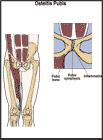
Osteitis Pubis
What is osteitis pubis?
Osteitis pubis, also known as pubic symphysitis, is pain and inflammation at the pubic symphysis. The pubic symphysis is where the right and left pubic bones meet. Your pubic bones are a part of the pelvis at your lower abdomen and groin.
How does it occur?
Osteitis pubis usually occurs from activities that you do often and repeat the same movement over and over, such as running or jumping.
What are the symptoms?
The most common symptom is pain directly over the pubic symphysis. The pain may begin gradually and may sometimes move to different places along the groin and pelvis. You may have pain in the groin, at the muscles that attach to the pelvis, and at the pubic bone.
How is it diagnosed?
Your health care provider will ask about your symptoms and examine you. You may have tenderness at your pubic bone or at the muscles that attach to the pubic bone. You may have an x-ray. Sometimes a bone scan is done to check for irritation at the pubic symphysis.
How is it treated?
This problem requires rest until the symptoms go away. If running causes pain, you should swim or bicycle instead. You may need to rest from all activities. Participating in activities that cause pain will mean that healing will take longer. Sometimes it takes 2 to 3 months for symptoms to go away. Anti-inflammatory medicines (such as ibuprofen) and putting an ice pack on the area for 20 to 30 minutes 3 to 4 times a day will help. Osteitis pubis requires more rest than rehabilitation and most of all requires patience.
When can I return to my sport or activity?
The goal is for you to return to your sport or activity as soon as is safely possible. If you return too soon you may worsen your injury, which could lead to long-term damage. Everyone recovers from injury at a different rate. Return to your sport or activity will be determined by when your pain goes away, not by how many days or weeks it has been since your injury occurred. In general, the longer you have symptoms before you start treatment, the longer it will take to get better.
You may safely return to your sport or activity when, starting from the top of the list and progressing to the end, each of the following is true:
- You do not have any pain or tenderness over the pubic bone.
- You can jog straight ahead without pain or limping.
- You can sprint straight ahead without pain or limping.
- You can do 45-degree cuts, first at half-speed, then at full-speed.
- You can do 20-yard figures-of-eight, first at half-speed, then at full-speed.
- You can do 90-degree cuts, first at half-speed, then at full-speed.
- You can do 10-yard figures-of-eight first at half-speed, then at full-speed.

